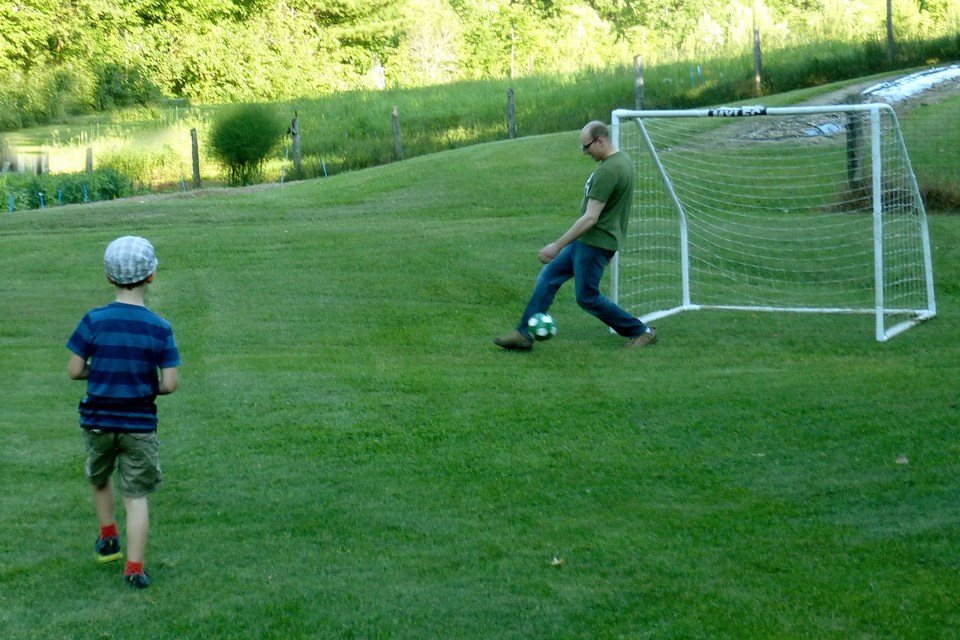Just about exactly 468 years ago (that would be circa 1540 AD for those of you who are bad at math) a new word was recorded. It was thought to be of Old French origin and mashed up a bit with Common Brittonic, thus "launde" and "llan" became merged to create "laune".
Forget the spelling for a moment and focus on the pronunciation: "law-on". Say it again. Look out the window and say it again. Yep, you got it.
Lawn is the latest configuration of spelling of a word that originally described a barren land, or clearing. The Celts used this word in reference to an enclosure within a place of worship. Perhaps this is why some people today worship their lawn, while others look at the view out the window as a barren clearing.
Perhaps I need something better to occupy my mind while doing yard work, but as load after load after load of raked leaves are removed from the grassy patches of my lawn, I began to wonder "who thought up this bizarre concept of lawns" and "why do they have to be immaculate"?
Indeed, what is the story behind this immaculate conception?
Similar to fences, lawns were a sign of aristocracy. If you had enough money to have someone build a fence around your property and keep the grass nice and short, you obviously had more money than brains and thus were placed within a certain segment of society.
If one could spend time managing land that produced neither crop nor pasture nor building upon it, then one was of a noble gentry.
First appearing in northern Europe, the fad soon spread to other estates, with land owners trying to out-snob each other with their lovely green swath. When the neighbours were looking the other way, goats, cattle and rabbits were turned loose on the lawn to clip it to a uniform height. By Sunday tea-time all the critters and their, ahem, deposits were removed to display to passers-by how truly elegant the family was.
A good lawn is a piece of art, as proven in the 1700s by Andre Le Notre when he created a patch of green vegetation within the gardens of Versailles, calling it "tapis vert" or "green carpet". That caught the attention of royal gardeners across both England and France. The very floral English gardens now became laced with grassy walkways and open grassy areas for socializing.
By 1780 grass seed was being sold for parks and residential areas, although still only to the wealthy. Staff replaced goats and rabbits, as they sheared the lawn to a state of monotonous beauty. After a few years of that labour-intensive nonsense, necessity mothered up with an invention and the first lawn mower was produced (patent applied for on Aug. 31, 1830 by Ed Budding).
As Europeans began flooding over to North America at this time, the notion of having a prestigious lawn also came along as baggage. And they brought Ed's cast iron beast of a mower with them. It took 10 years but when lighter alloys were invented the weight of a new mower became manageable and more practical.
Now some of the higher-ups, not just the uppity-ups, could afford a mower for their staff to push around in endless circles. As mowers became more affordable (made from thinner material and buoyed by high demand for production) a number of the common folk began to imitate the aristocratic landscape gardens on their own back yards.
Other factors began to come into play as society settled into a comfortable niche in this New World. There was the promotion of lawns as a safe place for children to play, and a place to grow fruits and vegetables instead of flowers.
Coincidentally, as natural pasture areas (marshes and sedge meadows) became overgrazed, farmers realized that they could plant nutritious grasses in these lawn areas, thus providing a field full of lush food for the cattle.
The lawn was becoming less of a status symbol and more of a standard of residential landscape structure. Town planners began demanding a set-back of thirty feet between a house and the sidewalk, thus creating the perfect place for a lawn. This was not lost on the lawn mower makers, as they produced the grass-clipping machines by the hundreds of thousands.
Next came the elimination of working on Saturday, as the 40-hour work week was introduced in 1938. This meant that the man of the house had to come up with something to do ... a-ha, the obvious!
And then along came Levittown. Abraham Levitt and his sons built 17,000 houses in New York between 1947 and 1951. These houses were laid out in a grid with each being a 'cookie-cutter' duplication of those around it.
Plunked square in the middle of the lot, each house had a front, back and two side lawns. As part of the selling pitch to these subdivided lands came the words, "No single feature of suburban residential community contributes as much to the charm and beauty of the individual home as well-kept lawns."
So there ya go ... if you buy into our community you will also maintain your lawn with equal gusto as your neighbour. Even green, short height, no dandelions, leaves to be removed as soon as possible, keep the kid's toys out of sight in the back yard. The need for uniformity that was stressed during WWII came home to the front yard.
All of which does not make me feel any better as I gather yet another armload of leaves to dump in the trailer. Maybe I should get a goat ... or bunnies.
